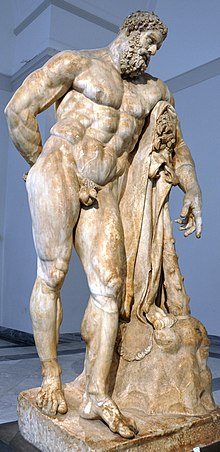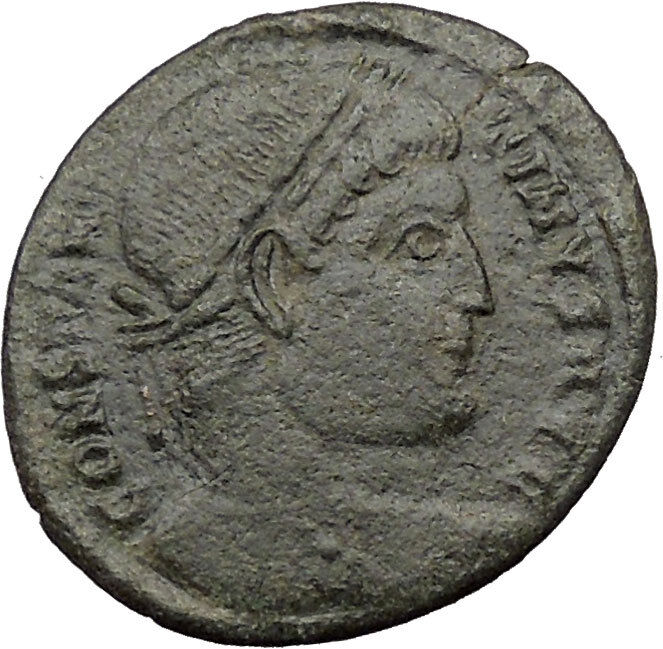|
Gordian III – Roman Emperor: 238-244 A.D. –
Silver Antoninianus 22mm (4.19 grams) Rome mint: 241-243 A.D.
Reference: RIC 95, C 404
IMP GORDIANVS PIVS FEL AVG – Radiate, draped and cuirassed bust right.
VIRTVTI AVGVSTI – the “Farnese” Hercules standing facing, head right, resting
hand on hip and placing left on club set on rock; lion skin beside club.
The model for this reverse type is the famed marble Farnese
Hercules statue that was discovered in the excavations of the Btahs of Caracalla
in 1546. It stood for over 200 year sin the Palazzo Farnese in Rome, from whence
it gained its name, and was moved to Naples in 1787, where it is now displayed
in the Museo Archeologico Nazionale. The statue is thought to be an enlarged
copy sculpted in early 3rd Century AD by Glykon based on an original by Lysippos
dating to the 4th century BC. The statue depicts Hercules at rest after
completing his labors: he is shown standing with his club, draped in the skin of
the Nemean lion, set upright on a rock, propped under his left arm supporting
the weight of his muscular frame, his head slightly nodding forward in a weary
attitude, and he holds the apples of the Hesperides behind his back in his right
hand. The sculpture was apparently well-liked by the Romans, and copies have
been found in Roman palaces and gymnasiums.
You are bidding on the exact
item pictured, provided with a Certificate of Authenticity and Lifetime
Guarantee of Authenticity.
The Farnese Hercules is an ancient sculpture, probably an enlarged
copy made in the early third century AD and signed by a certain Glykon, from an
original by Lysippos
(or one
of his

circle) that would have been made in the fourth century BC. The copy was
made for the Baths of
Caracalla
in Rome (dedicated in 216 AD),
where it was recovered in 1546.
History
The heroically-scaled Hercules
is one of the most famous sculptures of
Antiquity
, and has fixed the image of the mythic hero in the European
imagination. It quickly made its way into the collection of
Cardinal Alessandro Farnese
, grandson of
Pope Paul III.
Alessandro Farnese was well placed to form one of the greatest collections of
classical sculpture that has been assembled since Antiquity.
It stood for generations in its own room at
Palazzo Farnese, Rome
, where the hero was surrounded by frescoed depictions
of his feats by Annibale Carracci
and his studio, executed in the 1590s.
The Farnese statue was moved to Naples
in 1787 and is now displayed in the
Museo Archeologico Nazionale
.
The type was well known in Antiquity: a Hellenistic or Roman bronze
reduction, found at Foligno
is conserved in the Musée
du Louvre
; a small marble, probably Greek of the Roman period, is to be seen
in the Museum of the Ancient Agora, Athens (illustration).
The Farnese Hercules is a massive and muscular marble statue,
following a lost original
cast
in bronze
through a
method called
lost wax casting
. It depicts a weary
Hercules leaning on his
club, which has his lion-skin draped over it. He is performing one of the last
of
The Twelve Labours
, which is suggested by the
apples of
the Hesperides
he holds behind his back. This prominently-sited statue was
well liked by the
Romans
,
and copies have been found in Roman palaces and gymnasiums: another, coarser,
stood in the courtyard of Palazzo Farnese; one with the feigned (but probably
ancient) inscription “Lykippos” has stood in the court of
Palazzo Pitti,
Florence, since the sixteenth century.
Guglielmo
della Porta, the head had been recovered separately, from a well in
Trastevere, and was bought
for Farnese through the agency of della Porta, whose legs made to complete the
figure were so well regarded that when the original legs were recovered from
ongoing excavations in the Baths of Caracalla, della Porta’s were retained, on
Michelangelo‘s advice,
in part to demonstrate that modern sculptors could bear direct comparison with
the ancients. The original legs, from the
Borghese
collection, were not reunited with the sculpture until 1787.
Goethe
, in his Italian Journey, recounts his differing impressions upon
seeing the Hercules with each set of legs, marvelling at the clear superiority
of the original ones.
Hercules is caught in a rare moment of repose. Leaning on his knobby club
which is draped with the pelt of the
Nemean Lion
, he holds the apples of the
Hesperides in his right
hand, but conceals them behind his back like a baseball pitcher with a
knuckleball. Many engravings and woodcuts spread the fame of the Farnese’s
Hercules. By 1562 the find was already included in the set of engravings for
Speculum Romanae Magnificentiae (“Mirror of Rome’s Magnificence”)
and connoisseurs, artists and tourists gaped at the original, which stood in the
courtyard of the Palazzo Farnese, protected under the arcade. In 1590-91, during
his trip to Rome, Hendrik Goltzius
sketched the statue in the palazzo courtyard. Later (in
1591) Goltzius recorded the less-common rear view, in a bravura engraving (illustration,
right), which emphasizes the already exaggerated muscular form with swelling
and tapering lines that flow over the contours.
The young
Rubens
made quick sketches of the Hercules’ planes and massing. Before
photography, prints were the only way to put the image into many hands.

The Farnese Hercules, engraved by
Hendrick Goltzius
, 1591. Two onlookers give scale.
The sculpture was admired from the start, reservations about its exaggerated
musculature only surfacing in the later eighteenth century.
Napoleon remarked to
Antonio Canova that
its lack in the museum he accumulated in Paris was the most important gap in the
collection, and the sculpture was more than once crated ready for shipment to
Paris before the Napoleonic regime fled Naples.
Wealthy collectors could afford one of the numerous bronze replicas in sizes
for table-top display. A full-size marble copy that belonged to the Bourbons of
Naples is at the National Museum, Naples.
Copies of the Farnese Hercules appeared in 16th- and 18th-century gardens
throughout Europe. During construction of the
Alameda de Hercules
(1574) in Seville
, the oldest
public garden
preserved in Europe, on the cover were installed two columns
from a Roman temple, an unquestionable sign of admiration for the Roman
archaeological sites, elements of a building still preserved in the Marble
Street. On them were placed two sculptures by
Diego de Pesquera
, in 1574, of the Farnese Hercules, as founder of the city,
and of Julius Caesar
,
restorer of Híspalis. The first was a copy of the Farnese Hercules, near the
monumental size of the famous Roman marble from the
Baths of Caracalla.
At
Wilhelmshöhe
, near Kassel
,
a colossal version 8.5 m high produced by Johann Jacob Anthoni, 1713–1717, has
become the city’s mascot. André Le Nôtre
placed a full-size gilded version against the skyline at the
far end of the main vista at
Vaux-le-Vicomte. That
at
Versailles
is a copy by
Jean Cornu
, 1684–1686. In Scotland
a rare copy in lead
,
of the first half of the 18th century, is sited incongruously in the central
Highlands
, overlooking the recently restored Hercules Garden in the grounds
of Blair Castle.
Marcus Antonius Gordianus Pius (January
20, 225
–
February
11
, 244
),
known in
English
as Gordian III,
 was was
Roman
Emperor
from 238 to 244. Gordian was the son of
Antonia Gordiana
and his father was an unnamed Roman Senator who died before
238. Antonia Gordiana was the daughter of Emperor
Gordian I
and younger sister of Emperor
Gordian II
.
Very little is known on his early life before becoming Roman Emperor. Gordian
had assumed the name of his maternal grandfather in 238.
Following the murder of emperor
Alexander Severus
in Moguntiacum (modern
Mainz
), the
capital of the
Roman province
Germania Inferior
,
Maximinus Thrax
was acclaimed emperor, despite strong opposition of the
Roman senate
and the majority of the population. In response to what was
considered in Rome as a rebellion, Gordian’s grandfather and uncle, Gordian I
and II, were proclaimed joint emperors in the
Africa Province
. Their revolt was suppressed within a month by Cappellianus,
governor of Numidia
and a loyal supporter of Maximinus Thrax. The elder Gordians died,
but public opinion cherished their memory as peace loving and literate men,
victims of Maximinus’ oppression.
Meanwhile, Maximinus was on the verge of marching on Rome and
the Senate elected
Pupienus
and Balbinus
as joint emperors. These senators were not popular men and the population of
Rome was still shocked by the elder Gordian’s fate, so that the Senate decided
to take the teenager Gordian, rename him Marcus Antonius Gordianus as his
grandfather, and raise him to the rank of
Caesar
and imperial heir.
Pupienus
and Balbinus
defeated Maximinus, mainly due to the defection of several
legions
,
namely the
Parthica II
who assassinated Maximinus. But their joint reign was
doomed from the start with popular riots, military discontent and even an
enormous fire that consumed Rome in June 238. On
July 29
,
Pupienus and Balbinus were killed by the
Praetorian guard
and Gordian proclaimed sole emperor.
Rule
Due to Gordian’s age, the imperial government was surrendered
to the aristocratic families, who controlled the affairs of Rome through the
senate. In 240,
Sabinianus
revolted in the African province, but the situation was dealt quickly. In 241,
Gordian was married to Furia Sabinia
Tranquillina
, daughter of the newly appointed praetorian prefect,
Timesitheus
. As chief of the Praetorian guard and father in law of the
emperor, Timesitheus quickly became the de facto ruler of the Roman
empire.
In the 3rd century, the Roman frontiers weakened against the
Germanic tribes across the
Rhine
and
Danube
, and the
Sassanid
kingdom across the
Euphrates
increased its own attacks. When the Persians under
Shapur I
invaded Mesopotamia
, the young emperor opened the doors of the
Temple of Janus
for the last time in Roman history, and sent a huge army to
the East. The Sassanids were driven back over the Euphrates and defeated in the
Battle of Resaena
(243). The campaign was a success and Gordian, who had
joined the army, was planning an invasion of the enemy’s territory, when his
father-in-law died in unclear circumstances. Without Timesitheus, the campaign,
and the emperor’s security, were at risk.
Marcus Julius Philippus, also known as
Philip the Arab
, stepped in at this moment as the new Praetorian Prefect and
the campaign proceeded. In the beginning of 244, the Persians counter-attacked.
Persian sources claim that a battle was fought (Battle
of Misiche) near modern
Fallujah
(Iraq)
and resulted in a major Roman defeat and the death of Gordian III[1].
Roman sources do not mention this battle and suggest that Gordian died far away,
upstream of the Euphrates. Although ancient sources often described Philip, who
succeeded Gordian as emperor, as having murdered Gordian at Zaitha (Qalat es
Salihiyah), the cause of Gordian’s death is unknown.
Gordian’s youth and good nature, along with the deaths of his
grandfather and uncle and his own tragic fate at the hands of another usurper,
granted him the everlasting esteem of the Romans. Despite the opposition of the
new emperor, Gordian was deified by the Senate after his death, in order to
appease the population and avoid riots.
|







 was
was


